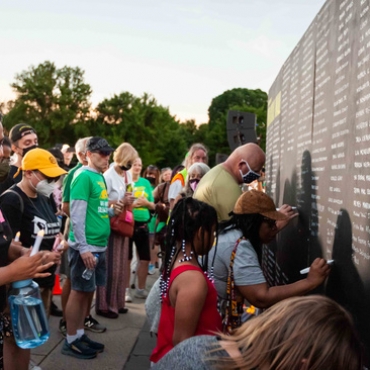Contact Admission
International Collaboration
AMA Morning Rounds
|
||||||||||
Leading the NewsCoronavirus may survive for 28 days on glass, banknotes, study suggestsBloomberg (10/11, Gale) reported, “The new coronavirus may remain infectious for weeks on banknotes, glass and other common surfaces, according to research by Australia’s top biosecurity laboratory that highlights risks from paper currency, touchscreen devices and grab handles and rails.” Researchers “showed SARS-CoV-2 is ‘extremely robust,’ surviving for 28 days on smooth surfaces such as glass found on mobile phone screens and plastic banknotes at room temperature, or 20 degrees Celsius (68 degrees Fahrenheit),” which “compares with 17 days survival for the flu virus.” The study was published in the Virology Journal. Reuters (10/12, Bikes) reports, “Experiments done at 20, 30 and 40 degrees Celsius showed the virus survived longer at cooler temperatures, longer on smooth surfaces than on complex surfaces such as cotton and longer on paper banknotes than on plastic banknotes.” CNBC (10/12) reports, “The researchers tested the survival rates of the virus, dried in an artificial mucous solution, at three different temperatures on six common surface areas.” All of “the experiments were carried out in the dark, however, since UV light has already been shown to kill the virus.” |
||||||||||
|
||||||||||
|
 |
People unable to get ACA subsidies continue to leave individual market, report finds
Bloomberg Law (10/9, Hansard, Subscription Publication) reported that “people who make too much money to get” Affordable Care Act “subsidies continue to leave the individual market, the...administration reported Friday.” Between “2016 to 2019, unsubsidized enrollment in Affordable Care Act-compliant individual plans dropped by 2.8 million people or 45%, the Department of Health and Human Services said.” A large share of those “enrolled in ACA plans are low- to middle-income people who benefit from subsidies, and the number of people who receive subsidies dropped far less than the number who didn’t get the subsidies.”
Pandemic coverage still has many “holes” which allow surprise medical bills
The AP (10/11, Murphy) reported that while “many” insurance companies “and the U.S. government have offered to pick up or waive costs tied to the virus, holes remain for big bills to slip through and surprise patients,” and the pandemic has “exposed well-known gaps in a system that mixes private insurers, government programs and different levels of coverage.” The article added, “The vast majority of...patients will incur few medical costs as they wait for their body to fight off mild symptoms. But patients who visit emergency rooms or wind up hospitalized may be vulnerable financially.”
 PUBLIC HEALTH
PUBLIC HEALTH
U.S. coronavirus death rate highest in developed world, study indicates
Bloomberg (10/12, Cortez) reports, “The proportion of Americans dying from coronavirus infections is the highest in the developed world, according to a study of global mortality rates that shows the U.S. pandemic response left citizens exposed to the lethal disease.” Early on “in the outbreak, the U.S. mortality rate from [COVID-19] was lower than in many other hard-hit countries, including the U.K., Spain and the Netherlands, according to the report” published in JAMA. However, “as spring turned to summer, the U.S. largely failed to embrace public-health and policy measures that have helped other countries reduce death rates.”
Study: COVID-19 pandemic might have caused 75K more fatalities in spring, summer than previously believed
USA Today (10/12, Rodriguez) reports, “The coronavirus pandemic may have caused tens of thousands of more deaths in the spring and summer than previously thought, a new study says.” Researchers “found nearly 75,000 more people may have died from the pandemic than what was recorded in March to July, according to the report published Monday in the peer-reviewed journal JAMA.” By examining “death certificates, the study found more than 150,000 deaths were officially attributed to COVID-19 during that period.” But, “researchers determined nearly 75,000 additional deaths were indirectly caused by the pandemic – bringing the total number of deaths for those four months to more than 225,000.”
NBC News (10/12, Edwards) reports one possible “explanation for the gap may be underreporting or misreporting of COVID-19-related deaths – in other words, not counting COVID-19 deaths.” The “study looked at death statistics from the National Center for Health Statistics, which is part of the Centers for Disease Control and Prevention, as well as the Census Bureau.”
COVID-19 pandemic said to have had an impact on people with mental illnesses
CNN (10/12, Howard) reports on the toll of the COVID-19 pandemic on people with mental illnesses. According to the results of a CDC survey published in August, “almost 41% of US adults...reported struggling with their mental health or substance use – both related to the coronavirus pandemic and some of the measures put in place to contain it, such as physical distancing.” Dr. Patrice Harris, the immediate past president of AMA, said, “Folks should also look to see what their local, state and county mental health authorities are doing because I know many of those authorities have developed crisis lines. We want people to know that they can access the help that they need when they need it.”
 HEALTH AND DIET
HEALTH AND DIET
 |
CDC says even people with moderate overweight may be at risk for severe COVID-19
The New York Times (10/10, Rabin) reported the CDC is warning that people with moderate overweight “may be more likely to become seriously ill when infected with the coronavirus.” Considering this warning, “nearly three-quarters of Americans may be at increased risk of severe COVID-19 if infected with the coronavirus.” Additional “medical conditions for which there is limited or mixed evidence of increased [COVID-19] severity include asthma, cerebrovascular disease and cystic fibrosis, the CDC said.” Those “medical conditions clearly shown to increase the risk of COVID-19 include cancer, chronic kidney disease, heart disease and sickle cell disease, among others.”
 PHARMA & DEVICE UPDATE
PHARMA & DEVICE UPDATE
Mallinckrodt begins opioid crisis-related bankruptcy proceedings
The AP (10/12) reports Mallinckrodt, “one of the highest-volume opioid producers in the U.S. at the height of the nation’s prescription drug crisis,” announced on Monday that it has initiated Chapter 11 bankruptcy proceedings. The aim of doing so, according to the Mallinckrodt announcement, is to help resolve “several billion dollars of otherwise unmanageable potential legal liabilities” that are connected to opioid crisis lawsuits filed against Mallinckrodt.
Reuters (10/12) reports Mallinckrodt has “filed for bankruptcy protection” as it faces “lawsuits alleging it fueled” the U.S. opioid crisis. The filing was submitted to the “U.S. Bankruptcy Court for the District Of Delaware.”
 FRIDAY'S LEAD STORIES
FRIDAY'S LEAD STORIES
• Hydroxychloroquine does nothing to prevent COVID-19 deaths, study suggests
• Survey: Average annual cost of family health plan increased to $21,342 in 2020
• Pregnancy rates among women 24 and younger hit record lows in 2016, research indicates
• Remdesivir may reduce recovery time in patients with COVID-19, researchers say
• AMA president speaks in favor of improving ACA during virtual town hall
|
Other library
- JAMA Dermatology Online First DECEMBER 03, 2025 ( 07:40 - 04/12/2025 )
- JAMA Internal Medicine New Issue December 2025; Volume 185, Number 1 ( 15:17 - 02/12/2025 )
- JAMA Internal Medicine Online First DECEMBER 01, 2025 ( 07:45 - 02/12/2025 )
- JAMA Dermatology Online First NOVEMBER 26, 2025 ( 07:35 - 27/11/2025 )
- JAMA Internal Medicine Online First NOVEMBER 24, 2025 ( 07:39 - 25/11/2025 )
- JAMA +AI Weekly Update November 22, 2025 ( 07:42 - 24/11/2025 )
- JAMA Dermatology Online First NOVEMBER 19, 2025 ( 07:41 - 20/11/2025 )
- JAMA masthead Online First NOVEMBER 17, 2025 ( 07:30 - 18/11/2025 )
- JAMA +AI One-Year Anniversary November 15, 2025 ( 07:44 - 17/11/2025 )
- JAMA Dermatology Online First NOVEMBER 12, 2025 ( 08:07 - 13/11/2025 )


















